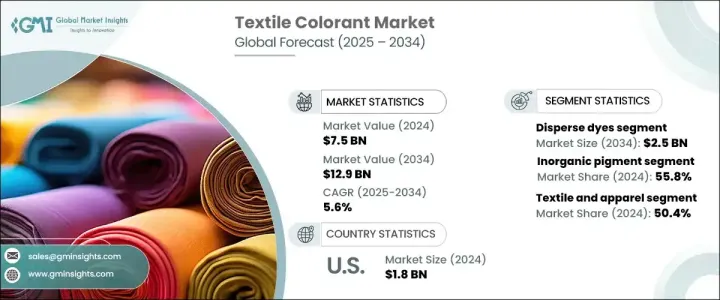
2024년 섬유용 착색제 세계 시장 규모는 75억 달러로 평가되었고, 2025년부터 2034년에 걸쳐 CAGR 5.6%로 성장할 것으로 예상됩니다.
이것은 패션과 가정용 섬유 제품에서 생생하고 오래 지속되는 염료에 대한 수요가 급증하고 있기 때문입니다. 소비자의 선호도가 지속가능성으로 변화함에 따라 환경친화적인 바이오 착색제가 지지를 모아 유기 염료 기술의 혁신을 촉진하고 있습니다. 패션 업계의 급속한 진화는 다양한 컬러 팔레트와 효율적인 염색 기술에 대한 수요를 계속 추진하고 있으며, 제조업체는 끊임없이 변화하는 동향에 대응할 수 있게 되었습니다.

지속가능성이 주목받고 있는 가운데, 기업은 최첨단의 물효율이 높은 염색 솔루션에 많은 투자를 하고 있습니다. 수질 오염에 대한 우려가 고품질의 결과를 유지하면서 환경에 미치는 영향을 최소화하는 물없는 염색법의 진보를 뒷받침하고 있습니다. 게다가 지속 가능한 실천을 촉진하는 규제 프레임워크은 무독성의 생분해성 섬유용 착색제로의 전환을 가속화하고 있습니다. 브랜드와 제조업체가 지속가능성을 우선시하는 가운데 혁신적인 염색 솔루션의 채용이 섬유 착색제의 전망을 재구축하여 장기적인 시장 확대를 확실히 하고 있습니다.
| 시장 범위 | |
|---|---|
| 시작 연도 | 2024년 |
| 예측 연도 | 2025-2034년 |
| 시작 금액 | 75억 달러 |
| 예측 금액 | 129억 달러 |
| CAGR | 5.6% |
염료 유형별로 볼 때 시장은 염기성 염료, 산성 염료, 직접 염료, 분산 염료, 반응 염료로 구분됩니다. 분산 염료는 지배적인 카테고리로, 2024년에는 16억 달러를 차지하고, 2034년에는 25억 달러에 이를 것으로 예측됩니다. 이러한 염료는 합성 섬유, 특히 세계 섬유 생산의 대부분을 차지하는 폴리 에스테르와 궁합이 좋기 때문에 선호됩니다. 신속한 납기와 저렴한 가격이 중요한 패스트 패션의 보급은 합성 섬유에 풍부하고 지속적인 색상을 제공하는 능력으로 분산 염료에 대한 수요를 강화하고 있습니다.
안료 유형별로 분류하면 시장은 유기 안료와 무기 안료로 나뉩니다. 무기 안료는 2024년에 55.8% 시장 점유율을 차지했는데, 이는 주로 뛰어난 색 안정성과 열과 빛에 대한 우수한 내성 때문입니다. 뛰어난 견뢰도를 가진 무기 안료는 옥외 섬유 및 고내구성 용도에 이상적입니다. 유기 안료에 비해 적당한 가격이기 때문에 대량 생산되는 섬유에 선호되어 업계에서의 지위를 더욱 견고한 것으로하고 있습니다.
2024년 18억 달러로 평가되는 미국 섬유용 착색제 시장은 견고한 섬유 제조거점, 끊임없는 기술 혁신, 고품질의 지속 가능한 염료에 대한 수요 증가에 힘입어 여전히 세계 지도자로 자리잡고 있습니다. 이 시장은 신속한 생산 사이클과 빠른 패션 및 홈 섬유 분야에 맞는 풍부한 컬러 솔루션으로 이익을 얻고 있습니다. 지속가능성이 중시되는 가운데, 바이오 베이스 염료나 천연 염료, 또한 물을 사용하지 않는 염색 기술에 대한 수요가 높아지고 있습니다. 환경안전성을 강화하는 규제압력은 친환경 염색 솔루션에 대한 투자를 더욱 촉진하고 미국 시장의 강력한 성장 궤도의 지속을 보장합니다.
The Global Textile Colorant Market, valued at USD 7.5 billion in 2024, is set to expand at a CAGR of 5.6% from 2025 to 2034, fueled by the surging demand for vibrant, long-lasting dyes in fashion and home textiles. As consumer preferences shift toward sustainability, eco-friendly and bio-based colorants are gaining traction, encouraging innovation in organic dye technologies. The fashion industry's rapid evolution continues to drive demand for a diverse color palette and efficient dyeing techniques, allowing manufacturers to keep pace with ever-changing trends.

With sustainability becoming a focal point, companies are investing heavily in cutting-edge, water-efficient dyeing solutions. Concerns over water pollution are pushing advancements in waterless dyeing methods, minimizing environmental impact while maintaining high-quality results. Furthermore, regulatory frameworks promoting sustainable practices are accelerating the transition toward non-toxic, biodegradable textile colorants. As brands and manufacturers prioritize sustainability, the adoption of innovative dyeing solutions is reshaping the textile colorant landscape, ensuring long-term market expansion.
| Market Scope | |
|---|---|
| Start Year | 2024 |
| Forecast Year | 2025-2034 |
| Start Value | $7.5 Billion |
| Forecast Value | $12.9 Billion |
| CAGR | 5.6% |
By dye type, the market is segmented into basic dyes, acid dyes, direct dyes, dispersed dyes, and reactive dyes. Disperse dyes, a dominant category accounted for USD 1.6 billion in 2024 and are projected to reach USD 2.5 billion by 2034. These dyes are preferred for their strong compatibility with synthetic fibers, particularly polyester, which continues to dominate global textile production. The prevalence of fast fashion, where quick turnarounds and affordability are key, has intensified demand for disperse dyes due to their ability to deliver rich, enduring color on synthetic fabrics.
When categorized by pigment type, the market is divided into organic and inorganic pigments. Inorganic pigments commanded a 55.8% market share in 2024, primarily due to their exceptional color stability and superior resistance to heat and light. With excellent color fastness, inorganic pigments are ideal for outdoor textiles and high-durability applications. Their affordability compared to organic pigments makes them a preferred choice for mass-market textiles, further solidifying their position in the industry.
The United States textile colorant market, valued at USD 1.8 billion in 2024, remains a leader in the global landscape, supported by a robust textile manufacturing base, continuous innovation, and increasing demand for high-quality, sustainable dyes. The market benefits from rapid production cycles and an extensive array of color solutions tailored to the fast fashion and home textile segments. As sustainability takes center stage, the demand for bio-based and natural dyes, along with waterless dyeing technologies, is on the rise. Regulatory pressures reinforcing environmental safety are further fueling investment in eco-friendly dyeing solutions, ensuring the U.S. market continues its strong growth trajectory.